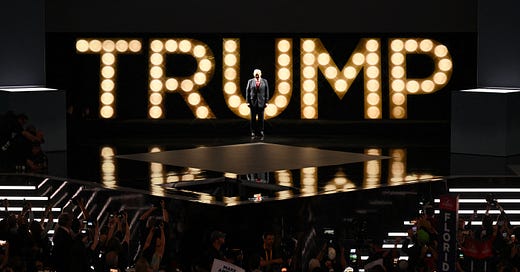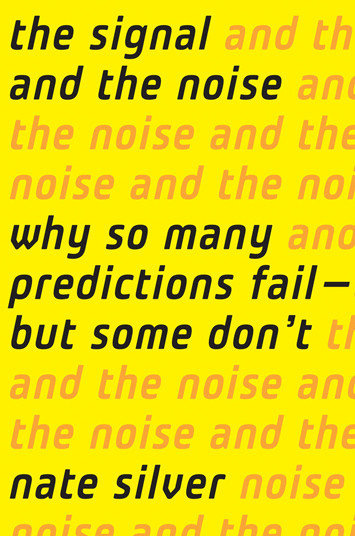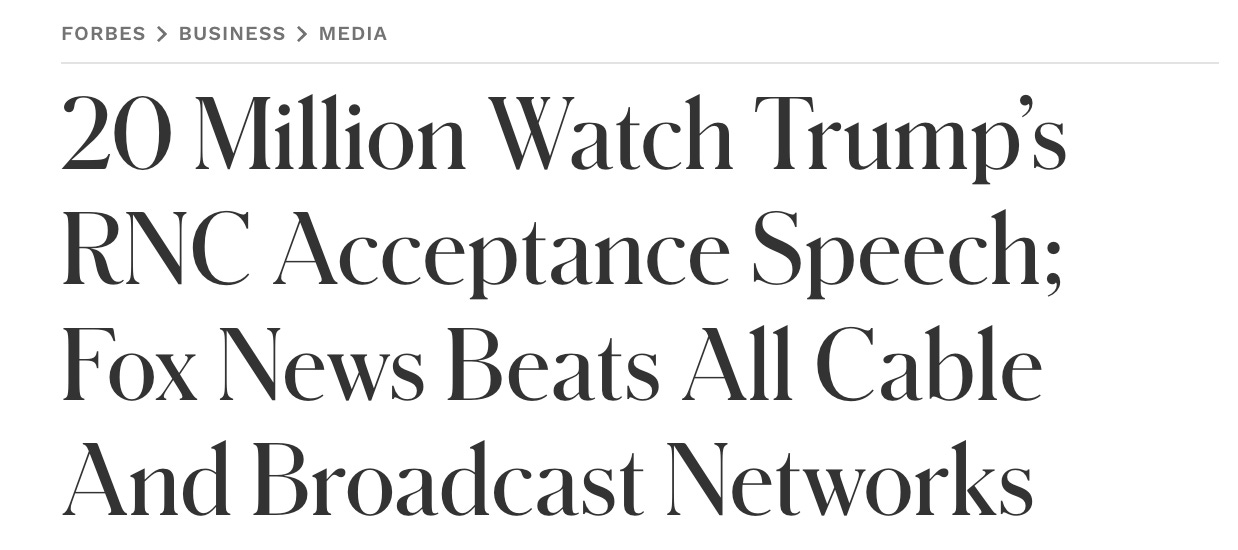I use Twitter. A lot. On Twitter, a deluge of knee-jerk lizard-brained takes inundate you at every moment. It becomes overstimulating. To quote Bo Burnham’s song “Welcome to the Internet” from his 2021 Netflix special Inside, “Can I interest you in everything all of the time? A little bit of everything all of the of the time?
When I watched the final night of the Republican National Convention last night, I felt as if I had two streams of this maximalist overstimulation. In front of me, I watched former President Donald Trump’s speech on a cable television, an antiquated medium that still finds a way into our homes. In my hand, I held my iPhone. With it, I could endlessly scroll through Twitter and get live takes on Trump’s speech in real-time.
In a world of infinite opinions … a little bit of everything all of the time … how do we know what to think? How can we discern the possible effect of a convention speech, a staple of American politics for decades? Everyone’s takes have a motive. An agenda. A bias. In the bright lights of this historic 2024 campaign, how do we not miss the forest for the trees?
Trump’s entrance evoked something of a residency show on the Las Vegas Strip. Maybe if this presidency thing doesn’t work out, he can follow U2’s footsteps in the Sphere. Bright lights blazed bright into our eyes and formed Trump’s name, the name that we have seen for decades adorning hotels and casinos and, for the past decade, on political paraphernalia. Overstimulation. That’s what I felt last night. And maybe it’s what I have felt since 2015, but — amid the takes — what can we glean from this flamboyant Liberace-esque stage production?
As my brother so wisely remarked to me yesterday, “a presidential election is the Super Bowl of words”. It is true. No physical contact. The opponents only exchange words with one another. We must just analyze words, to which I have become addicted since 2016. I need everyone’s takes all the time. What will Nate Silver think of this speech? Ann Coulter? Ezra Klein? Jennifer Rubin? Matt Yglesias? Van Jones? The list of characters in my take-o-sphere online simulated reality goes on and on like a receipt at a CVS.
My general takeaway from the speech was that the first 15 minutes had great impact, but the next 80 minutes bored me. I went to bed and did not finish it, but with a Twitter profile with 100 followers and a Substack with about two dozen subscribers, my opinion does not have much of an impact. I care more about what the behemoths of the take economy (or the “wet market of ideas”) have to say.
The immediate consensus of the Twitterati at the tail end of the speech posited that Trump had killed all of his momentum following the assassination attempt. He had just given a speech equally as bad as Biden’s debate performance from June 27. I wish that I could give you a slew of tweets that communicate this message, but I can’t because of the nature of Twitter. Tweets flutter away in the wind, and — if you fail to bookmark or like them — you may never see them again. A ship passing in the night.
Nate Silver’s Tweets during the Speech:
I can give the thoughts from Nate Silver, whose thread last night demonstrates what I am trying to say about Twitter overall and the convention speech itself.
The screenshot above displays Silver’s sequence of three tweets in response to the convention. His first tweet gives praise. The second tweet acknowledges the boringness of the speech but the fact that a boring speech probably does not move the needle much. The final tweet gives a full retraction of his two prior takes and floats the idea that neither party wants to win this election.
These three tweets create a spectrum. The first tweet offers the first impression, informed by primacy bias, while the final tweet gives the immediate response at the conclusion. Can we form our opinion on either extreme? I do not think that we can, so I argue that the truth sits somewhere in the middle of these extremes in our mercurial, temporal emotions and perceptions. In the context of the specific example of Silver’s tweets, I would say — in an admittedly rudimentary way — that the second tweet has the most relevance as 24 hours pass.
The Forest and the Trees:
I do not speak for Silver, but — after cooling off — I think that he would say that certain other events in this race have much bigger impact than this speech. We have had three unprecedented events in this election, and the speech is not one of them:
A former president (and now presidential nominee) became a felon on 34 different counts.
The incumbent president gave the worst debate performance ever and revealed that he may not have the mental fitness to complete the campaign. Subsequently, many top figures in his party want to remove him from the ticket.
A former president (and now presidential nominee) survived an assassination attempt during a campaign rally and came just a few millimeters from death.
A convention speech happens every election for both parties’ nominees. A felony conviction, a intra-party mutiny, and an assassination attempt do not happen every election. Just one of those events occurring would make this election unprecedented and historically exceptional, and we have gotten all three in a two-month span.
The distinction between all of these events coincides with my larger goal of not missing the forest for the trees. Silver would refer to this goal as distinguishing the signal from the noise, which informed the title of his best-selling 2012 book.
I might have a bias, but I would say that the debate disaster and the assassination attempt serve as signals. The former definitely does because its cascading impact has not abated. At this moment, reports are still emerging that Democrats are trying to topple President Joe Biden. We are even seeing that Biden’s family is discussing options for him to leave the race. Not enough polls have come out that can properly reflect a timeframe after the assassination attempt.
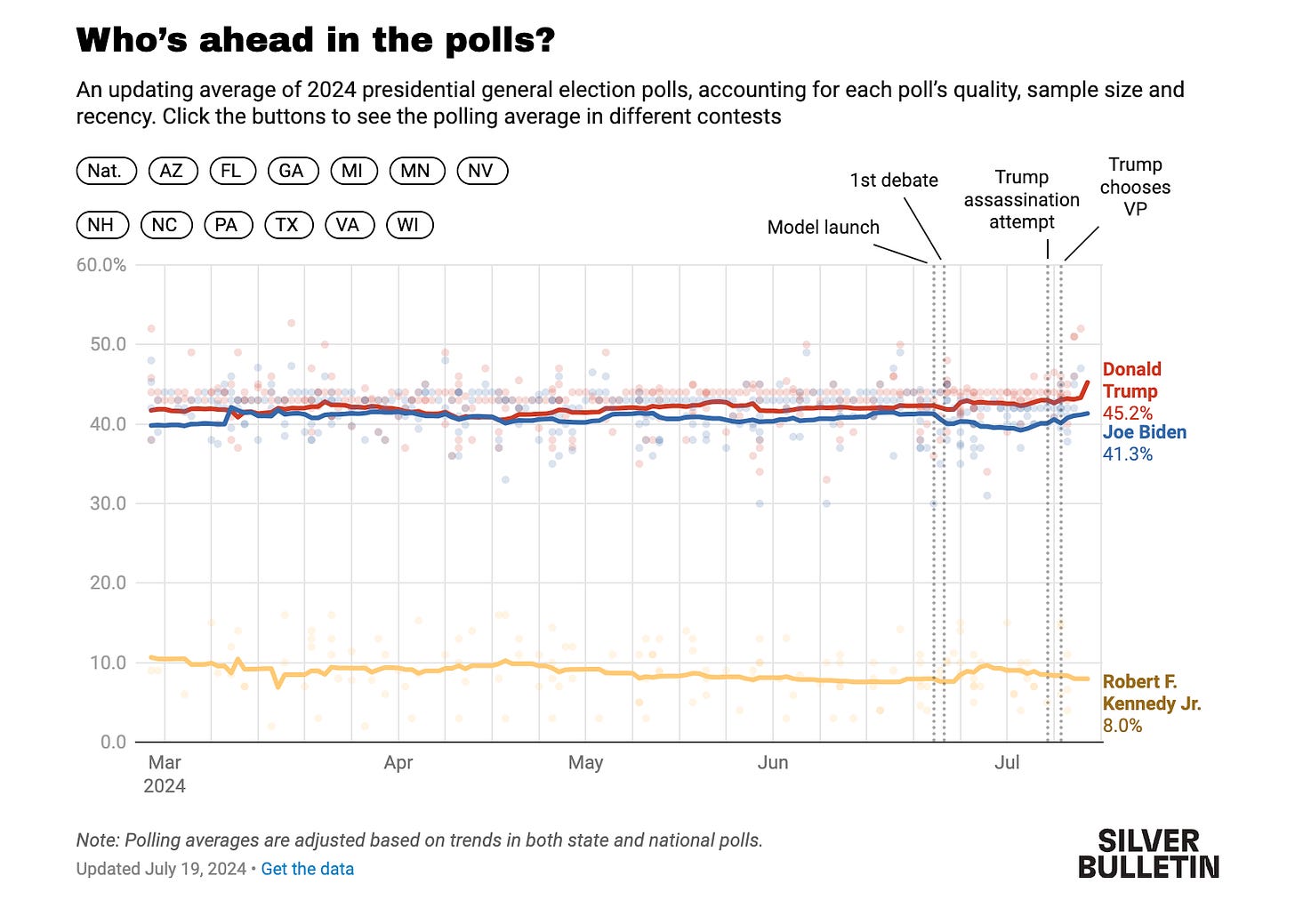
Nonetheless, the past few days of polling have led to Trump’s sharpest increase in polling as you can see at the tail end of the polling averages from Silver’s forecast shown above.
At the same time, Biden’s chances of victory keep sinking, and — at the moment of me writing this article — he has achieved another low at a 25.8% chance.
Silver’s forecast assumes a polling bump after a party’s convention, and that bump eventually dissipates. Consequently, he hedges much of the increases during and immediately after the convention, but Trump has still shot up in his odds despite that handicap.
A Risk-Averse Trump:
Everyone who is not a hack agrees that Trump is the favorite in the race at the moment. He is a strong favorite. According to Silver’s forecast he is approximately a 3:1 favorite. Trump has run as the GOP nominee in three presidential elections, including this one, so far. He has never found himself in such a good position in 8 years of running for president. In 2020, Biden led 100% of days in the national polling averages. In 2024, Trump has so far led 100% of days, and we know the inherent advantage that the GOP has in the Electoral College.
According to the graphic above, Biden must be leading the popular vote by 2-3 percentage points to earn an edge in the Electoral College. Even then, he only has a 63% chance of winning it, and the current state of the race shows an inversion of that situation. According to Silver’s current average, Trump leads Biden by 3.9 percentage points. Therefore, if we held the election today, Trump most certainly would win, but Silver’s model assumes a reversion to the mean.
He assumes that Biden will rebound gradually and eventually, leading to his current forecast of Trump winning the popular vote by only 0.9 percentage points. Even that margin would be historic because no Republican presidential nominee has won the popular vote since George W. Bush did so in 2004. He won it by 2.4 percentage points.
As a general rule, if a candidate finds himself in this position so far ahead, he should implement more aversion to risk in his strategy. On the other side of the coin, the underdog needs to take risks and throw Hail Mary passes. In this case, the underdog of Joe Biden threw a Hail Mary pass already when he pushed for a June debate, the earliest in the history of presidential debates. Obviously, that choice backfired, but perhaps it still was the correct play. As Silver has also said, the Biden campaign isn’t really getting any good hands if this were a poker game.
Conversely, Trump might be getting the best hands that a presidential candidate has ever gotten in recent memory. The entire country is questioning his opponent’s mental fitness to do the job, and many people in the president’s own party are trying to backstab him. On top of the chaotic revolt against Biden within the Democratic Party, Trump has achieved pseudo-martyr status to his supporters after surviving an assassination attempt, whereby the bullet grazed his ear right next to his cranium. For those not fanatical about Trump, they might see the images from the assassination attempt in Pennsylvania as exuding strength, which perfectly juxtaposes with images of Biden’s mouth agape at the June debate.
Unfortunately, for Trump, we live in a hyper-polarized environment. Elections will always have razor-thin margins by historical standards. If Donald Trump were running in 1984, perhaps he would win 49 states as Ronald Reagan did. That’s impossible now.
Larry Sabato’s Crystal Ball posted this map above yesterday (July 18), and it shows their Electoral College prediction if Biden stays in the race and he does not improve. Even with Trump’s providentially fortuitous poker hands, he does not move the map that much. If he wins all the toss-ups here, he would only win 5 states which he didn’t win in his successful run in 2016: Maine, Minnesota, Nevada, New Hampshire, and Virginia. An Electoral College victory of 342 votes is impressive, but it’s not 49-state landslide impressive.
Despite the polarized environment, Trump is still the clear favorite. He does need to adopt that risk-taking strategy, so what does he do? Well, he has been doing it. Between the debate and the convention, he only made three public appearances: campaign rallies in Virginia, Florida, and Pennsylvania (the site of the assassination attempt). He barely made any Truth Social statements. He played his hand perfectly and defied all the past, undisciplined behavior that he has routinely demonstrated for the past eight years of running for president.
I believe that the mediocre convention speech falls in line with that strategy. It did not move the needle at all. Not only did it not have to move the needle, but it also shouldn’t have moved the needle. Trump did not need to deliver a fire-and-brimstone “American carnage” barnburner as he did at the 2016 convention.
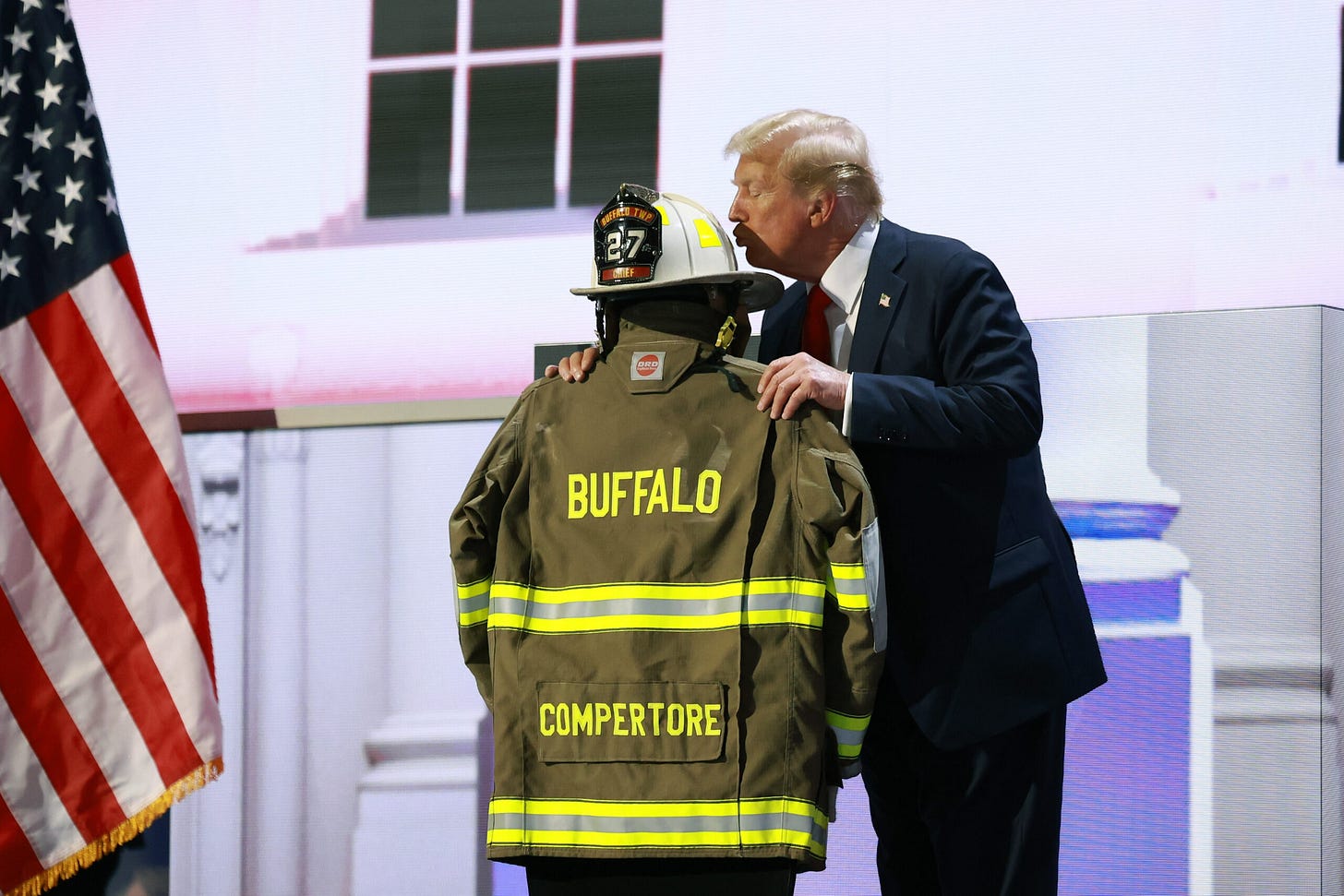
Trump obviously did incorporate some unique elements. He spoke on the assassination attempt. He brought with him on stage the firefighter uniform of Corey Comperatore, the man who tragically lost his life at the rally in Butler, Pennsylvania.
Before the speech itself and Donald Trump’s entrance, WWE star Hulk Hogan gave a speech evoking Terry Crews as President Dwayne Camacho of the 2006 film Idiocracy. Dana White, president of the UFC, introduced Donald Trump. As I already showed, Trump had the lights spelling his name.
It was all very Vegas. Maybe there’s a reason Trump is leading Biden in Nevada by 6 percentage points. Only Trump could coherently cobble together a theater production with the patriotic comfort food of a Lee Greenwood live performance with the flamboyant exuberance of Liberace. The Trump-Vance ticket is existing in a quantum state in which Trump is going full Vegas Strip showman while Vance is cosplaying as a steelworker in Ohio, and it’s working so far!
Furthermore, despite the theatrics of everything leading up to the triumphant return of Trump post-shooting, Trump gave an anti-climatic rambling, but maybe that’s okay. It won’t move the needle. It was not memorable, and if voters don’t register any new memorable, negative information about Trump, then we will remain the favorite.
I will give one statistic from the speech that I think encapsulates my takeaway. Twenty million people watched Trump’s acceptance speech in Milwaukee while fifty million people watched Biden’s disastrous debate performance in Atlanta three weeks ago. If we are going to look at this from a simplistic arithmetic perspective, then Biden’s poor debate performance had 2.5 times more of an impact on the electorate than Trump’s mediocre speech, and I don’t think that ratio gives the full context.
For one, Trump’s speech did not signal a major medical emergency as Biden’s performance did. In addition to that fact, as seen in the Forbes headlines above, Fox News had the largest ratings. I cannot fully verify this hypothesis of mine, but that fact would imply that mostly right-leaning people were watching the speech. In other words, the people watching the speech were most likely people whose votes won’t waver from Trump anyway.
Final Thoughts:
Analyzing a boring speech that not many people watched and even fewer watched in its entirety is missing the forest for the trees. It is confusing the noise for the signal. For the first time ever, Trump should be boring. The media will always critique him somehow, and if the critique is that he had a boring meandering speech, that might be the best critique possible for the Trump campaign.


